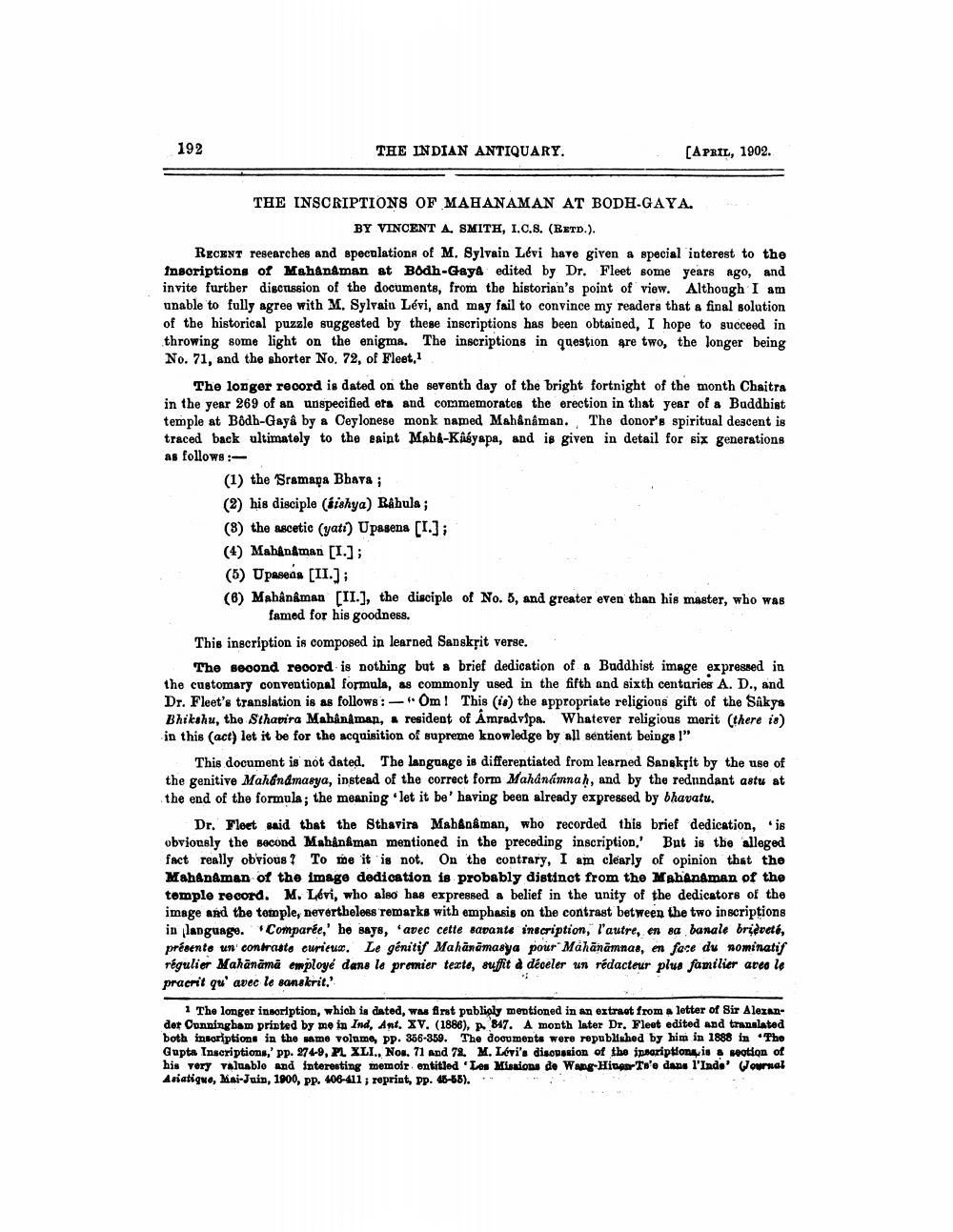________________
192
THE INDIAN ANTIQUARY.
[APRIL, 1902.
THE INSCRIPTIONS OF MAHANAMAN AT BODH-GAYA.
BY VINCENT A. SMITH, I.C.S. (RETD.). RECENT researches and speculations of M. Sylvain Lévi have given a special interest to the Inscriptions of Mahanaman at Bodh-Gay& edited by Dr. Fleet some years ago, and invite further discussion of the documents, from the historian's point of view. Although I am unable to fully agree with M. Sylvain Lévi, and may fail to convince my readers that a final solution of the historical puzzle suggested by these inscriptions has been obtained, I hope to succeed in throwing some light on the enigma. The inscriptions in question are two, the longer being No. 71, and the shorter No. 72, of Fleet,
The longer record is dated on the seventh day of the bright fortnight of the month Chaitra in the year 269 of an unspecified ets and commemorates the erection in that year of a Buddhist temple at Bodb-Gaya by a Ceylonese monk named Mah&naman. The donor's spiritual descent is traced back ultimately to the saint Maha-Kasyapa, and is given in detail for six generations as follows:
(1) the Sramapa Bhara; (2) his disciple (rishya) Rahula ; (8) the ascetic (yatt) Upasena [1.]; (4) Mahậnkman [I.]; (5) Upaseda (II.); (6) Mabånaman [II.], the disciple of No. 3, and greater even than his master, who was
famed for his goodness. This inscription is composed in learned Sanskrit verse.
The second record is nothing but a brief dedication of a Buddhist image expressed in the customary conventional formula, as commonly used in the fifth and sixth centaries A. D., and Dr. Fleet's translation is as follows: - * Om! This is the appropriate religious gift of the Säkya Bhikshu, the Sthanira Mahanaman, & resident of Amrad vipa. Whatever religious merit (there is) in this (act) let it be for the acquisition of supreme knowledge by all sentient beings !"
This document is not dated. The language is differentiated from learned Sanskrit by the use of the genitive Mahandmasya, instead of the correct form Mahânámnah, and by the redundant astu at the end of the formula; the meaning let it be having been already expressed by bhavatu.
Dr. Fleet said that the Sthavira Mahanaman, who recorded this brief dedication, is obviously the second Mahanaman mentioned in the preceding inscription. But is the alleged fact really obvious ? To me it is not. On the contrary, I am clearly of opinion that the Mahanaman of the image dedication is probably distinct from the Mahanaman of the temple record. M. Levi, who also has expressed a belief in the unity of the dedicators of the image and the temple, nevertheless remarks with emphasis on the contrast between the two inscriptions in language. Comparée,' he says, avec cette sapante inscription, l'autre, en sa banale brièveté, présente un contrasto curieux. Le génitif Mahānāmasya pour Māhānamnas, en face du nominatif régulier Mahānāmā employé dans le premier texte, suffit à déceler un rédacteur plus familier avec le pracrit qu'avec le sanskrit.'
1 The longer insoription, which is dated, was first publisly mentioned in an extract from a letter of Sir Alexandet Conningham pripted by me in Ind, Ant. XV. (1886), p 847. A month later Dr. Fleet edited and translated both insoriptions in the same volume, pp. 366-359. The documents were republished by him in 1888 in The Gupta Inscriptions,' pp. 274-9, PL XLI., Nos. 71 and 72. M. Levi's disopssion of the inscriptionis & section of his very valuablo and interesting memoir entitled 'Les Missions de Wang-Hiuear Ts'e dans l'Inde' Wournal Asiatique, Mai-Juin, 1900, PP. 408-411 ; reprint, pp. 46-58).




